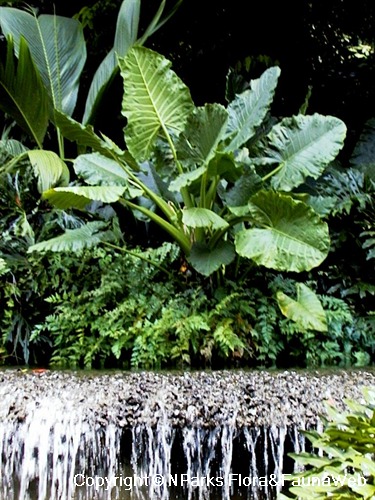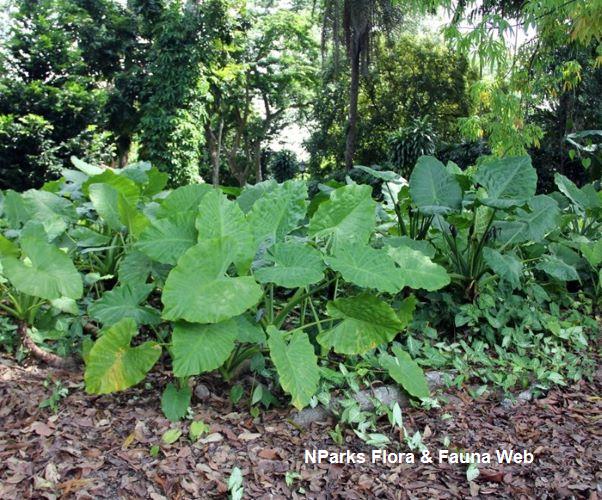
Back
Alocasia macrorrhizos (L.) G.Don
| Family Name: | Araceae |
| Common Name: | Giant Taro, Greater Alocasia, Birah Negeri, Elephant's Ear |
Giant Taro is used in landscaping for its large, heart-shaped leaves which resemble elephant ears.
Name
Classifications and Characteristics
| Plant Division | Angiosperms (Flowering Seed Plants) (Monocotyledon) |
|---|---|
| Plant Growth Form | Herbaceous Plant |
| Lifespan (in Singapore) | Perennial |
| Mode of Nutrition | Autotrophic |
| Plant Shape | Open |
| Maximum Height | 3.7 m to 4.6 m |
| Maximum Plant Spread / Crown Width | 1.8 m to 2.4 m |
Biogeography
| Native Distribution | Central Malesia to Queensland |
|---|---|
| Native Habitat | Terrestrial (Agricultural Land, Secondary Rainforest, Riverine, Disturbed Area / Open Ground) |
| Preferred Climate Zone | Tropical, Sub-Tropical / Monsoonal |
| Local Conservation Status | Non-native (Spontaneous (Naturalised)) |
Description and Ethnobotany
| Growth Form | Perennial herb up to 2-4 m tall (but sometimes reaching 5 m). |
|---|---|
| Foliage | Arranged in rosettes, ascending; leaf blades are flattened, pointing upwards, measures 25 - 50 cm by 20 - 35 cm, green in colour, slightly glossy, arrow-shaped, apex acute, base hastate, margin wavy, petiole measuring 60 - 100 cm long. |
| Stems | Acaulescent, has a short corm, produces sap and has an elongated caudex as it grows. |
| Flowers | Inflorescences, enfolded by bracts; peduncles are 20 - 45 cm long, spathe white - yellowish green with 15 - 35 cm long, lower part folds into a green tube; spadix 11 - 32 cm long, pistil 3 -4 cm long and 1.5 cm thick. |
| Fruit | Fleshy berry, globose or ovoid in shape, turns red when matures. |
| Cultivation | This species grows best in bright light with light shade and moist, but well-drained loamy soil. However, it can tolerate shade to full sun and sandy to clayey soils. |
| Ethnobotanical Uses | Food (Fruit or Vegetable): All parts of the plant contain toxic calcium oxalate. In India, Bangladesh, Malaysia and other parts of southeastern Asia, the corm (underground storage organ) and stem are carefully cooked in multiple rounds to thoroughly breakdown the oxalates before eating it as a vegetable. |
Landscaping Features
| Desirable Plant Features | Ornamental Foliage |
|---|---|
| Landscape Uses | Parks & Gardens, Pond / Lake / River |
| Thematic Landscaping | Economic Garden |
| Usage Hazard - Cons | Toxic Upon Ingestion, Irritant - Contact Allergy |
| Usage Hazard - Cons Remarks | Requires prolonged preparation and boiling to breakdown toxic calcium oxalate crystals which occur throughout the plant. The crystals may also irritate the skin upon contact. |
Fauna, Pollination and Dispersal
| Pollination Method(s) | Biotic (Fauna) (Insects (Ant, Beetle, Fly, Thrip, Wasp)) |
|---|
Plant Care and Propagation
| Light Preference | Full Sun, Semi-Shade |
|---|---|
| Water Preference | Lots of Water |
| Plant Growth Rate | Fast |
| Rootzone Tolerance | Moist Soils, Well-Drained Soils |
| Potential Problems | In wet, poorly drained soil, it is prone to root rot. |
| Propagation Method | Seed, Storage Organ (Corm, Tuberous Stem), Sucker |
Foliar
| Foliage Retention | Evergreen |
|---|---|
| Mature Foliage Colour(s) | Green |
| Mature Foliage Texture(s) | Glossy / Shiny |
| Foliar Modification | Storage Organ |
| Foliar Type | Simple / Unifoliate |
| Foliar Arrangement Along Stem | Rosulate / Rosette |
| Foliar Attachment to Stem | Petiolate |
| Foliar Shape(s) | Non-Palm Foliage (Sagittate) |
| Foliar Margin | Entire - Wavy / Undulate |
| Foliar Apex - Tip | Acute |
| Foliar Base | Hastate |
| Leaf Area Index (LAI) for Green Plot Ratio | 3.5 (Shrub & Groundcover - Monocot) |
Floral (Angiosperm)
| Flower Grouping | Cluster / Inflorescence |
|---|---|
| Flower Location | Axillary |
| Inflorescence Type | Spathe & Spadix |
Fruit, Seed and Spore
| Mature Fruit Colour(s) | Red |
|---|---|
| Mature Seed Colour(s) | Brown |
Image Repository
Others
| Master ID | 340 |
|---|---|
| Species ID | 1636 |
| Flora Disclaimer | The information in this website has been compiled from reliable sources, such as reference works on medicinal plants. It is not a substitute for medical advice or treatment and NParks does not purport to provide any medical advice. Readers should always consult his/her physician before using or consuming a plant for medicinal purposes. |






.jpg)
